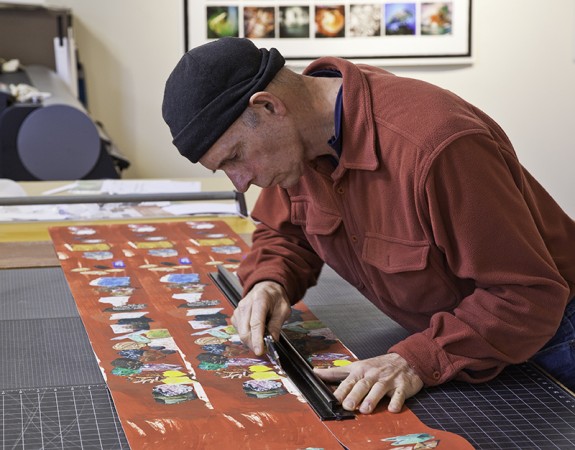ARTISTS. PHOTOGRAPHERS. If you have ever had reproductions or enlargements made of your work, you understand the value of personalized service. A good printmaker can
serve as a partner in helping you produce works that you will be proud to display and sell. One such company is The LightRoom in Berkeley, California.
In business since 1975, the LightRoom offers one-on-one fine-art printing and film-scanning services to photographers and artists. Company owner Rob Reiter is known for suggesting alternate printing options and different papers and materials. He encourages photographers and artists to look beyond the obvious and traditional ways to present their work: “We have so many materials and tools at our disposal today, the only limitations are our imaginations.”
 Recently, Reiter joined with artist Ellen Weiner to print reproductions of her original accordian fanfold art books. When printed on a wide roll of media on his 44-inch Canon iPF 8300 inkjet photo printer, eight 30-page fanfold books could be reproduced as a single 109-inch long print. Some of the books were also output as 20-inch high panoramic prints for gallery display.
Recently, Reiter joined with artist Ellen Weiner to print reproductions of her original accordian fanfold art books. When printed on a wide roll of media on his 44-inch Canon iPF 8300 inkjet photo printer, eight 30-page fanfold books could be reproduced as a single 109-inch long print. Some of the books were also output as 20-inch high panoramic prints for gallery display.
“I heard a dozen negative replies from photographers and printers when I described my project,” says Weiner. She said most turned down the job because they had never done it before. Reiter accepted the challenge: “I didn’t see any reason to not do it, but I knew problems would probably creep in,” said Reiter. “Still, it sounded interesting and I love working with clients to solve these kinds of problems.”
Reiter began the project by scanning the pages. The first problem arose when he tried to align all the scans so they could be trimmed down and easily folded. Lining up each page in the series didn’t guarantee that each page fold was at exactly 3.5 inches.
So he laid out gridlines for each fold and assembled the scans to bring each fold of the original book into the proper alignment on the print. Reiter and Wiener also experimented with different inkjet papers to find one with minimal surface cracking when folded. Most of the books were output on Epson UltraSmooth Fine Art Paper.
Another problem came after the final printing was done. The books were printed as eight strips across a roll of wide-format inkjet paper. The 9-ft. long print was too big to fit in a standard paper cutter. So, Reiter unrolled the print and used a straight-edge and razor to slice each strip from the print. With enough patience and a steady hand, Reiter eventually became proficient. Even with the challenges he encountered in printing the eight books, Reiter is happy with the experience.
The LightRoom has been producing archival pigment prints (giclees) for artists since the late 1990s. The LightRoom website includes detailed explanations of the processes, quality-control procedures, and a wide variety of papers and canvases available.
LINKS

